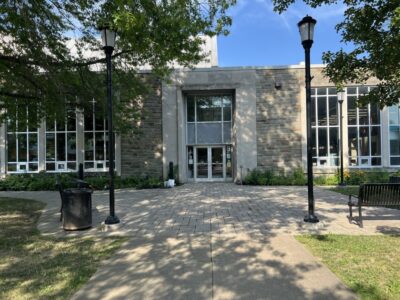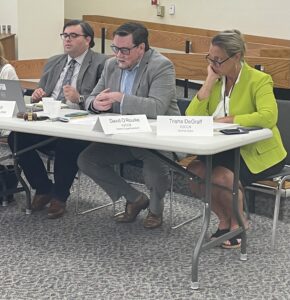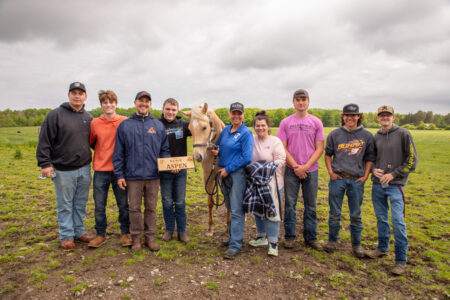Helping Prevent Harm
Vigilance Is Key On New Invasive Species Threats To Lake

Pictured above, Dan Conklin joins Chautauqua Watershed Conservancy Seasonal Aquatic Invasive Species Coordinator Sandra Emke on an invasive species paddle at Long Point State Park. Photo by Jay Young
Work targeting invasive species on Chautauqua Lake takes on several different forms over the course of the year. Some non-native plants are well-established and require long term management, others grow in select areas and can be targeted on a smaller scale. Last but not least, there are invasive species that are not currently growing in the lake (as best we can tell), and many people are hard at work trying to keep it that way.
Together, alliance member programs address three main pieces of invasive species management: prevention, early detection, and rapid response. In addition to the work done by Chautauqua Lake Association watercraft stewards and annual lakewide plant surveys, the Chautauqua Watershed Conservancy’s volunteer kayak paddles help keep the alliance vigilant of any new invaders. These public events take place over the course of the warmer months in an effort to both target known populations of problem plants (like water chestnut in the outlet) and keep an eye out for any new species. For example, hydrilla is a very problematic invasive plant that has not been detected in the lake, but is present in some areas of Western New York. On September 26, staff from the alliance joined CWC for an invasive paddle out of Long Point State Park.
As you can tell from the photo above, large algae blooms have been prominent in the last several weeks, including in parts of Bemus Bay near the survey area. These conditions may be related to the recent spell of warm and dry weather we have experienced, along with other factors that are actively being researched. As of last week around 70 blooms had been recorded for Chautauqua Lake in 2024 via the statewide NYHABS database. Each year that platform allows observers to submit photos and GPS coordinates of potential algae blooms for confirmation and archiving.
The volunteer paddle began on the north side of Long Point, circling around the swimming beach south towards the marina in Bemus Bay. While some paddles target known populations of plants for management, this survey was more broad and on the lookout for any of the several species known to cause problems locally. No hydrilla was found, and over the course of the day no detections were made of the invasives present in other areas of the lake, such as brittle naiad, starry stonewort, or water chestnut. As to be expected, there were detections of our well-established invasives curly-leaf pondweed and Eurasian watermilfoil. CWC Seasonal Aquatic Invasive Species Coordinator Sandra Emke indicated that known populations of water chestnut in the Chadakoin outlet were once again managed via hand pulling in 2024. Emke also mentioned that water chestnut was also removed from isolated ponds on Maplehurst Country Club. While these populations are not connected to the lake directly, water chestnut can be spread by waterfowl from one body of water to another.
As we know from years of experience with different species, vigilance early on often means a much lower management cost down the road. The quicker invasive species can be identified and targeted, the less money and effort is required to address them. Local stakeholders are currently hoping to use this approach to target two areas of starry stonewort growth in Ashville Bay and Prendergast Point. The towns of Chautauqua and North Harmony have secured state grants, and are working on permitting to perform diver-assisted suction harvesting of the algae in order to help stop its spread. CWC Director of Conservation Twan Leenders will be leading the monitoring and site mapping for this work, and CWC’s volunteer paddles have been vital to tracking the growth of starry stonewort over the past several years.
Because this species is an emerging issue and there is no well-established best management practice, different approaches are being considered. This includes pilot testing of mechanical removal, which was performed in 2022 and 2023. The Chautauqua Lake Partnership is also assessing chemical management options at locations in the South Basin. An overview of this work can be found on the alliance website at chautauquaalliance.org/ssw/.
Gauging the success of an invasive species search can be a bit of a double-edged sword at times. On the one hand –no news can be good news. If you do not find a species that is harmful to the environment, perhaps it’s simply not there. On the other hand –if you do find an invasive species, you now have the opportunity to record its location and make a management decision. Maybe you decide to do a more detailed survey after a detection. It is not necessarily black and white. What is clear is the impact that the public can have on this work, whether that be by participating in a volunteer paddle, or reporting their own sightings of problem species via imapinvasives.org/. More information on CWC’s invasive species programs can be found at chautauquawatershed.org/.




